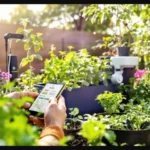Imagine waking up to the smell of fresh herbs growing in your kitchen, tomatoes ripening in your smart greenhouse, and your phone notifying you that your plants have just been watered—all automatically. Welcome to smart home farming.
This isn’t just a futuristic concept anymore. Thanks to rapidly advancing technology, even people living in apartments or small homes can grow their own food using smart farming techniques.
In this beginner’s guide to smart home farming, we’ll walk you through what it is, how it works, why it matters, and how to get started—step by step. Whether you’re a curious newbie or a tech-savvy gardener, this guide will help you grow food with confidence.
🚀 What is Smart Home Farming?
Smart home farming combines smart home technology and urban agriculture to help you grow vegetables, herbs, and even small fruits at home using sensors, automation, and data.
It’s like having a personal farmer—only digital.
With smart home farming, you can automate watering, lighting, temperature control, and even receive real-time updates on your plants’ health. The best part? You don’t need a backyard. Even your kitchen counter or a balcony can become a productive farming space.
👉 Learn more about what smart farming is
🧠 How Does Smart Farming Work?
The magic lies in IoT (Internet of Things) and AI-powered systems. Here’s how it usually works:
- Sensors track humidity, light, moisture, and temperature.
- Controllers (like smart plugs or apps) adjust light and water.
- Apps collect data and alert you when something needs your attention.
- Automation kicks in to water your plants or turn on lights based on preset conditions.
Some popular devices include:
These tools make smart gardening accessible, even for people with zero gardening experience.
🌿 Benefits of Smart Home Farming
Still wondering if it’s worth the effort? Here’s why smart home farming is catching on:
✅ Healthier Eating
Grow your own organic herbs, leafy greens, or even strawberries. You’ll know exactly what’s going into your body.
✅ Saves Money
Once set up, you’ll spend far less on groceries—especially herbs and greens.
✅ Convenience
Automated systems mean no forgetting to water or overwatering. Your smart garden handles the details.
✅ Eco-Friendly
You save water, reduce carbon footprints, and eliminate the need for harmful pesticides.
✅ Mental Wellbeing
Growing something is satisfying and reduces stress. Think of it as tech-powered therapy.
🔧 Step-by-Step: How to Start Smart Home Farming
Let’s break it down into manageable steps for beginners.
Step 1: Choose Your Farming Style
Here are some great options for beginners:
- Hydroponics – Grow plants in nutrient-rich water. Ideal for herbs and leafy greens.
- Soil-Based Smart Pots—Great for tomatoes, peppers, and carrots.
- Aquaponics – Fish and plants in one system (intermediate-level).
Step 2: Pick a Location
Choose a spot in your home that has:
- Access to electricity
- Moderate temperature
- Good air circulation
Ideal places:
- Kitchen countertops
- Balcony or patio
- Basement (with grow lights)
Step 3: Get the Right Equipment
Here’s what you’ll need to start your smart home garden:
✅ Smart Planters
These come with built-in water tanks, LED grow lights, and soil monitors.
Try: Click and Grow
✅ Smart Irrigation Systems
Control watering via your phone. Great for soil-based farming.
Try: Eve Aqua
✅ Grow Lights
Essential if your location doesn’t get much natural light.
Try: GE Grow Light Bulbs
✅ Sensors & Monitors
Track soil pH, moisture, and nutrients.
Try: Xiaomi Mi Plant Monitor
Step 4: Choose Easy-to-Grow Crops
As a beginner, start with crops that are simple to grow:
- Basil
- Lettuce
- Mint
- Chives
- Spinach
- Cherry Tomatoes
Step 5: Connect Everything to Your Smart Home System
If you use Alexa, Google Assistant, or Apple HomeKit, many devices will connect easily.
Example:
“Alexa, water my basil plant.” 🌿
You can also set automation like:
- “Turn on grow lights at 6 AM.”
- “Water every 3 days.”
🛠️ Pro Tips for Beginners
- Don’t overwater. Trust your sensors.
- Use organic nutrients. Many smart systems support them.
- Check your app regularly. It’s your farming assistant.
- Label everything. If you’re growing multiple plants, you’ll thank yourself.
💬 A Real-Life Story: Sarah’s Balcony Garden
Sarah lives in a small apartment in New York. She always loved the idea of gardening but didn’t have the space—or time.
Then, she bought a Click and Grow Smart Garden and set it up in her kitchen. Within three weeks, she had fresh basil, mint, and parsley growing—without lifting a finger after the initial setup.
“I never thought I’d be eating homegrown salad from my apartment,” she laughs. “My kids love it, and it’s actually fun.”
Her smart home garden even became a conversation starter during dinner parties!
🛍️ Where to Buy Smart Home Farming Tools
Here are some top platforms:
🤔 Frequently Asked Questions (FAQ)
❓ What is smart farming?
Smart farming is the use of advanced tech like IoT, AI, and automation to optimize the process of growing crops, even in urban settings.
❓ Can I start smart home farming in an apartment?
Absolutely! Many devices are designed for small spaces, making it perfect for apartment dwellers.
❓ Is smart farming expensive?
It can be as affordable or premium as you want. Starter kits begin at around $50.
❓ Do I need gardening experience?
Not at all. Smart systems are designed for beginners. The tech handles most of the work.
❓ What if I forget to water?
No worries—automated watering systems and app notifications have you covered.
🎯 Final Thoughts: Why You Should Start Today
A beginner’s guide to smart home farming isn’t just about plants—it’s about taking control of your food, your health, and your lifestyle. With just a small investment, you can transform your home into a mini-farm that works with you, not against you.
You don’t have to be a tech genius or a master gardener. Just a curious mind and a willingness to try something new.
✅ It’s healthy.
✅ It’s smart.
✅ It’s the future of urban living.
So why not start your smart farming journey today?



